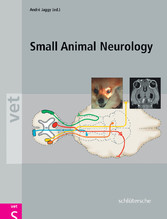Suchen und Finden
Table of Contents
8
Contributors
17
Preface to the English edition
22
Preface to the second German edition
23
Preface to the first German edition
24
Abbreviations
25
1 Neurological Examination of Small Animals
28
1.1 Signalment
28
1.2 Anamnesis
28
1.3 General examination
29
1.4 Neurological status
29
1.5 Ophthalmological examination
61
Literature
64
2 Principles of Neuropathology
66
2.1 General neuropathology
66
2.2 Classification of neurological diseases: VITAMIN D
75
2.3 Investigation of the cerebrospinal fluid ( CSF)
80
Further reading
82
3 Genetic Neurological Diseases and Breed Predisposition
84
3.1 Genetic defects
84
3.2 Inheritance
85
3.3 Demonstrating the mode of inheritance
85
3.4 Testing for potential genetic carriers
87
3.5 Breeding methods to eradicate genetic defects
88
3.6 Diseases due to multifactorial causes
89
Literature
90
4 Basic Laboratory Investigations
92
4.1 Indications
92
4.2 Haematology
93
4.3 Biochemical blood parameters
95
4.4 Urine investigations
98
Further reading
98
5 Anaesthesia
100
5.1 Basics of neuroanaesthesia
100
5.1.1 Control of intracranial pressure
101
5.1.2 Control of the carbon dioxide partial pressure
102
5.1.3 Control of blood pressure
103
5.1.4 Pharmaceuticals
103
5.1.5 Positioning
104
5.1.6 Supervision of anaesthesia and hypothermia
104
5.1.7 Fluid therapy
104
5.1.8 Recovery period
105
5.2 Specific procedural techniques
105
Literature
112
Further reading
112
6 Neuroradiology
114
6.1 Indications
114
6.2 Examination methods
116
6.3 Spine
124
6.4 Specific diseases
139
6.5 Skull
152
Literature
172
7 Electrodiagnostics
180
7.1 Electrodiagnosis of the peripheral nervous system ( PNS)
181
7.1.1 Electromyography (EMG)
182
7.1.2 Electroneurography
184
7.1.3 Auditory evoked potentials (AEP)
188
7.2 Electrodiagnostic examinations of the CNS 7.2.1 Electroencephalography
190
7.3 Biopsy
196
7.3.1 Muscle biopsy
196
7.3.2 Nerve biopsy
197
8 Rehabilitation
198
8.1 Physiotherapy
198
8.1.1 Hydrotherapy
199
8.1.2 Massage
199
8.1.3 Kinesiotherapy
201
8.1.4 Electrotherapy
202
8.1.5 Thermotherapy
205
8.1.6 Magnetic field therapy
205
8.2 Adjuvant therapeutic measures
205
9 Neuropharmacology
210
9.1 Antibiotic therapy in neurological disease
210
9.1.1 Classes of antibiotics and their antibiotic spectra
210
9.1.2 Choice of antibiotic depending on neurological lesion localisation
213
9.2 Steroid therapy
214
9.2.1 Chemistry, pharmacokinetics and clinical pharmacology
214
9.2.2 Physiological and pharmacological effects
215
9.2.3 Side-effects
216
9.2.4 Therapeutic uses
216
9.3 Analgesics
218
9.3.1 Principles of pain physiology and therapy
219
9.3.2 Opioids
220
9.3.3 Non-steroidal anti-inflammatory drugs
220
9.3.4 Other medications and treatments used in pain relief
223
Literature
224
Further reading
224
10 Neurosurgery
226
10.1 Instrumentation
226
10.2 Brain
227
10.2.1 Brain tumours
228
10.2.2 Cranial trauma
231
10.2.3 Hydrocephalus
232
10.3 Spinal cord/ Spine
233
10.3.1 Diseases of the intervertebral discs
233
10.3.2 Diseases of the cervical intervertebral discs
234
10.3.3 Diseases of the thoracolumbar intervertebral discs
237
10.3.4 Diseases of the lumbosacral intervertebral discs
239
10.3.5 Tumours of the vertebral body, spinal cord and nerve roots
239
10.4 Spinal fractures / luxations
242
10.5 Peripheral nerves
249
10.6 Surgery of the middle and inner ear
254
11 Acupuncture
258
11.1 Introduction
258
11.1.1 Acupuncture in traditional Chinese medicine ( TCM)
258
11.1.2 The acupoints
258
11.1.3 Choice of acupoints
259
11.1.4 Activation of the acupoints
259
11.2 The use of acupuncture in neurological disease
260
11.3 Acupunctural analgesia and postoperative pain relief
261
12 Stabilization of the Neurological Emergency Patient
264
12.1 General aspects
264
12.2 Stabilization of selected neurological emergencies
271
13 Peripheral Nervous System and Musculature
298
13.1 Introduction
298
13.2 Mononeuropathies
302
13.3 Polyneuropathies
314
13.4 Neuromuscular transmission abnormalities
327
13.5 Monomyopathies
335
13.5.1 Ischemic myopathies
335
13.5.2 Myositis of the masticatory muscles
337
13.5.3 Extraocular myositis
338
13.5.4 Myopathy of the gracilis and semitendinosus muscles
339
13.5.5 Myopathy of the infraspinatus muscle
339
13.5.6 Myositis ossificans
340
13.5.7 Coccygeal myopathy ( limber tail, cold tail)
341
13.6 Polymyopathies
342
14 Spinal Cord
360
14.1 Spinal cord diseases
361
14.1.1 Vascular diseases
361
14.1.2 Inflammatory changes
364
14.1.3 Traumatic diseases
366
14.1.4 Anomalies
368
14.1.5 Metabolic diseases
375
14.1.6 Neoplastic diseases
376
14.1.7 Degenerative diseases of the spine and spinal cord
378
14.2 Bladder disturbances
392
15 Vestibular Apparatus
398
15.1 Functional anatomy
398
15.2 Disturbances of vestibular function
399
15.2.1 Paradoxical vestibular syndrome
400
15.2.2 Clinical symptoms with bilateral disease
401
15.3 Neurological examination of a vestibular syndrome
401
15.4 Diseases of the peripheral vestibular apparatus
402
15.4.1 Otitis media / interna
403
15.4.2 Congenital vestibular diseases
405
15.4.3 Metabolic causes
406
15.4.4 Idiopathic causes ( geriatric or idiopathic vestibular syndrome)
407
15.4.5 Neoplastic disease
407
15.5 Diseases of the central vestibular apparatus
408
16 Cerebellum
412
16.1 Anatomy and physiology
412
16.2 Symptomatology and localisation of cerebellar lesions
413
16.3 Differential diagnoses ( VITAMIN D) and investigation methods
416
16.4 Diseases
417
16.4.1 Congenital cerebellar disease
417
16.4.2 Acquired diseases of the cerebellum
421
17 Brain Stem
426
17.1 Anatomy
426
17.2 Diseases
426
17.3 Neuro-ophthalmology
443
18 Cerebrum
454
18.1 Anatomy and physiology
455
18.2 Neuroanatomical localisation
455
18.3 Adjunct investigations
457
18.4 Diseases of the cerebrum
457
18.5 Epilepsy
473
18.6 Differential diagnoses for primary and secondary epilepsy
480
18.7 Neoplasia
484
18.8 Degenerative diseases
488
19 Behavioural Problems and Abnormal Behaviour
494
19.1 Aggression in the dog
494
19.2 Aggression in the cat
501
19.3 Problems associated with excretory behaviour of cats
504
19.4 Fears and phobias in the dog and cat
507
19.5 Compulsive disturbances
509
19.6 Cognitive dysfunction in the dog and cat
511
19.7 Medical behavioural therapy
512
20 Parasitic Neurological Diseases of the Dog and Cat
518
20.1 Trypanosomiasis in the dog
518
20.2 Neosporosis in the dog
518
20.3 Toxoplasmosis in the cat and dog
520
20.4 Babesiosis in the dog
521
20.5 Acanthamoeba infections
522
20.6 Encephalitozoonosis
522
20.7 Neurological diseases caused by helminths
523
20.8 Neurological diseases caused by arthropods
524
20.9 Borreliosis
524
Appendices
528
Subject Index
600
Alle Preise verstehen sich inklusive der gesetzlichen MwSt.











